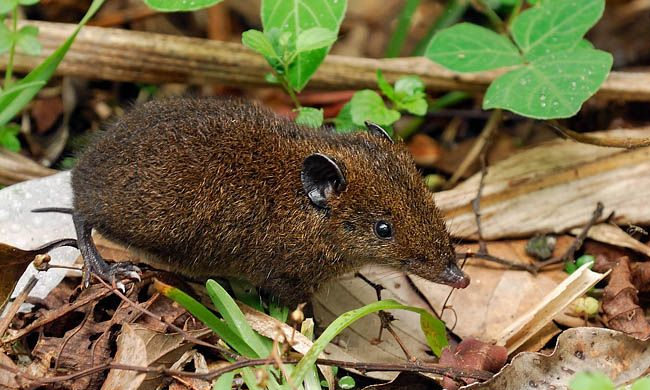If you cannot find the answer you are looking for, please contact us.
Kitanglad gymnure

Recognized as a distinct species in 2023, the Kitanglad Gymnure is the smallest known member of its genus, found exclusively in the cloud forests of the Kitanglad Mountain Range in Mindanao.
Taxonomy
| Kingdom: | Animalia |
| Phylum: | Chordata |
| Class: | Mammalia |
| Order: | Eulipotyphla |
| Family: | Erinaceidae |
| Genus: | Podogymnura |
| Species: | Podogymnura truei |
Not a ‘real’ hedgehog
The Kitanglad Gymnure belongs to the hedgehog family, but it is a gymnure, or “hairy hedgehog,” not a spiny hedgehog. It does share traits with true hedgehogs, such as being nocturnal, insectivorous, and having an excellent sense of smell. Yet it lacks defensive spines or the ability to roll into a ball, instead having soft fur, a pointed snout, and a slender body, giving it more resemblance to a shrew, while remaining a close evolutionary cousin of hedgehogs.
Natural range & habitat
This species is endemic to the Kitanglad Mountain Range in northern Mindanao, Philippines. It inhabits montane forest, including swampy and mossy patches, usually found at elevations between 1,300 and 2,800 m. Within this cloud forest environment, individuals are most often encountered along narrow ground paths, beneath moss-covered roots, fallen logs, or leaf litter, environments rich in invertebrate prey.
Physical traits
The Kitanglad Gymnure is the smallest species in the Podogymnura genus, with a body length of around 13.7 to 15.2 cm, and a tail of 4.9 to 6.6 cm, making it about 36 % the length of its body. Weight ranges between 63 and 79 g. The fur is soft, long, and dark reddish-brown, with faint golden-yellow tips that give a subtle speckled appearance. Its ears (2.0–2.2 cm) and feet are pale, and the tail is uniformly light-colored underneath. The skull is slender, with a long, pointed rostrum and relatively short parietal crests. The skull length is between 37.3 and 39.8 mm, with a braincase width around 15–16 mm.
Behavior & lifestyle
This gymnure is nocturnal and terrestrial, moving through dense forest floor debris and using hidden runways for movement. It is likely solitary and highly secretive, its small size and cryptic behavior make it seldom seen. It shows a preference for moist, moss-rich forest floors and avoids open or disturbed terrain.
Communication
No specific studies exist, but like other gymnures, it likely relies on scent marking, subtle tactile cues, and possibly soft vocalizations. Its cryptic lifestyle in dense forest suggests that chemical communication is paramount.
Diet in the wild
Stomach content analyses show that it feeds predominantly on earthworms, which account for about half of its diet, and also consumes various arthropods such as weta or ground-dwelling insects, often chewing its prey into small 3–20 mm pieces.
Reproduction & life cycle
Lorem ipsumFemales typically produce one offspring, though rarely two. Juveniles and sexually active males have been observed between March and June, suggesting a possible seasonal breeding period. Detailed life history information remains limited.Lorem ipsum
Threats & conservation status
This gymnure is currently not assessed separately by the IUCN and remains grouped under the Mindanao Gymnure, which is considered Least Concern. Despite residing within the protected Mount Kitanglad Range Natural Park, it faces threats from local deforestation and habitat disturbance that may impact its highly localized populations.
This species in captivity
There are no known records of the Kitanglad Gymnure being held in captivity. Its specialized habitat, small population, and elusive nature make it unsuitable for captive maintenance or breeding programs. Conservation focus is, now more than ever, fully in situ, preserving the montane forests it calls home.
